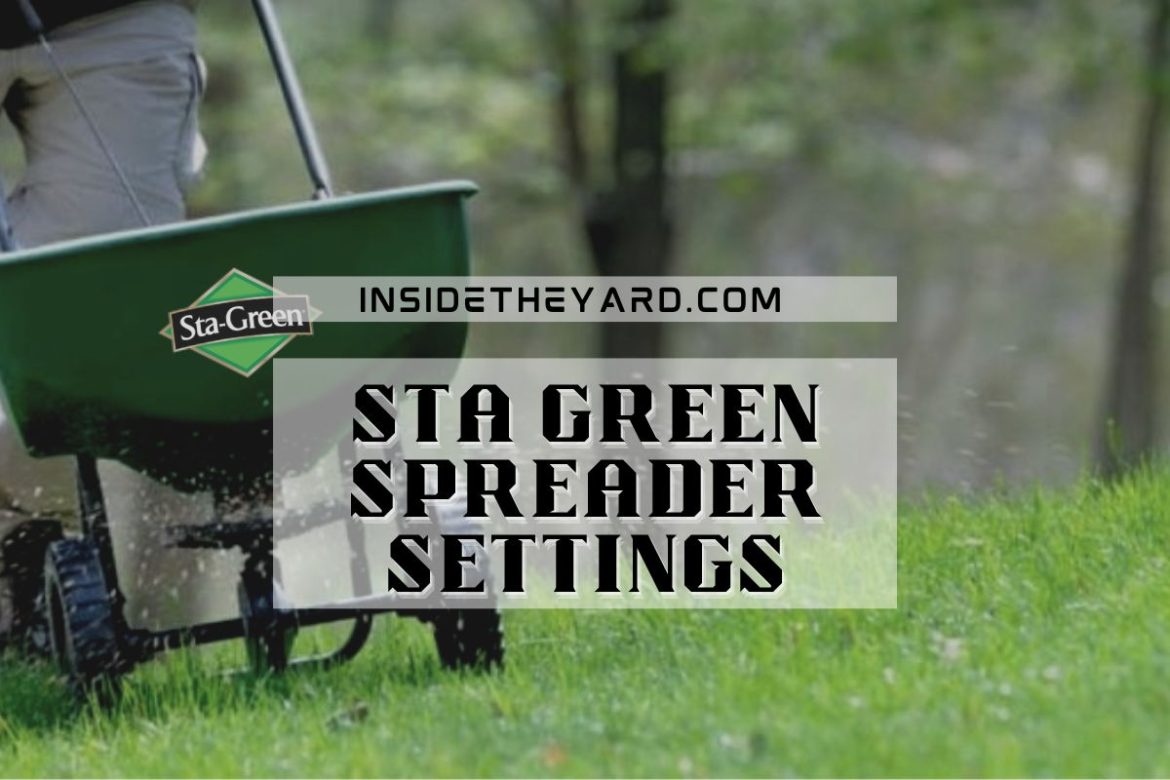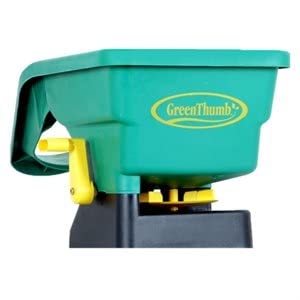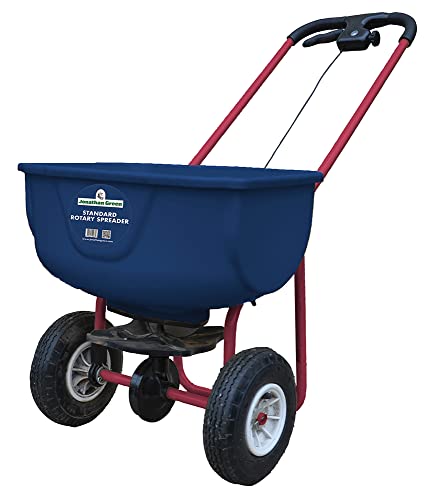Sta-Green Spreader is the ultimate tool for distributing fertilizer in your garden, ensuring even coverage and optimal plant growth. With multiple spreading options available, this simple device caters to a wide range of user requirements.
But the question remains — which settings are best suited for specific products to yield the desirable outcome? Unfortunately, there is no one-size-fits-all answer to this question.
On average, you can opt for a 1.5-1.75 setting for drop spreaders and 4-4.5 for rotary spreaders.
Still, these values may vary depending on the type of spreader you’re using and the size of the product being dispersed. Calibrating your spreader to find the optimal settings is crucial for satisfying results.
This article outlines all the essential criteria and settings you need for your specific spreader. Understanding these factors and tailoring them to your requirements will ensure compatibility with the most popular gardening products.
Sta-Green Spreader Settings Chart
Searching for the optimum settings for your go-to product can be time-consuming. To make this task less demanding, we’ve created the following chart. Use it to set the optimum settings for your particular type of Sta-Green Spreader.
| Brand and Product Name | Settings For Drop Spreader | Settings For Rotary Spreader |
| Estate Premium Lawn Care 24-0-12 Crabgrass Preventer | 1.75 | 4.5 |
| Green Pro Weed N’ Feed 25-0-8 | 1.75 | 4.5 |
| BCA Premium Lawn Starter 18-22-6 | 1.75 | 4.5 |
| Estate Premium Lawn Care Lawn Fertilizer 27-0-9 | 1.75 | 4.5 |
| Estate Premium Lawn Care Winterizer 24-0-16 | 1.75 | 4.5 |
| Superior All Natural Fertilizer 5-5-0 | 5 | 9 |
| Pendelton Turf Supply Garden Fertilizer 13-13-13 | 1.75 | 4.5 |
| Maxlawn Crabgrass Preventer 22-0-4 | 1.5 | 4 |
| Maxlawn Weed & Feed 24-0-4 | 1.5 | 4 |
| Maxlawn Lawn Food 26-0-4 | 1.5 | 4 |
| Maxlawn Winterizer 22-0-10 | 1.5 | 4 |
| Maxlawn Starter Fertilizer 12-24-6 | 1.5 | 4 |
| Expert Gardener 10-10-10 All-Purpose Fertilizer | 2 | 4 |
| Forever Green Crabgrass Preventer 24-0-3 | 1.5 | 4 |
| Scotts Weed & Feed 26-0-3 | 1.5 | 4 |
| Expert Gardener Weed & Feed 28-0-3 | 1.5 | 4 |
| Forever Green Starter Fertilizer 10-18-6 | 1.5 | 4 |
| Jonathan Green Crabgrass Preventer 20-0-3 | 1.5 | 4 |
| Jonathan Green Green-Up Weed & Feed 21-0-3 | 1.5 | 4 |
| Jonathan Green Green-Up Lawn Food 29-0-3 | 1.5 | 4.5 |
| Jonathan Green Winter Survival Fall Lawn Fertilizer 10-0-20 | 2 | 4.5 |
| Jonathan Green Organic Lawn Food 10-0-1 | 1.5 | 4.5 |
It’s worth noting the figures above are only an approximation.
Fertilizers come in various sizes, with some particles being small and others quite large. Because of that, you must manually test which setting will be most suitable for your needs.
- To start, take a moment to examine the largest particle in your chosen fertilizer. Holding this particle in your hand, you’ll need to select the appropriate setting on your Sta-Green spreader.
- As you adjust the spreader setting, double-check that the particle can easily drop from the spreader, ensuring smooth and even distribution across your lawn or garden.
- Once satisfied with the settings and test results, continue the application process.
Why Are These Settings Important?
If you own a Sta-Green Spreader and want to nourish your lawn, determining the most compatible settings is a vital step. Proper calibration ensures the spreader dispenses the right amount of product per unit area, promoting a healthier, lush green lawn.
Balancing these settings is essential, as both overfeeding and underfeeding can lead to unfavorable outcomes.
Overfeeding your lawn with fertilizers and other lawn care products can cause damage to the grass. This is especially true when using synthetic fertilizers or insecticides, which can easily burn the grass if applied in excessive amounts.
On the other hand, underfeeding will result in no visible improvement, rendering product usage ineffective.
Taking this into account, there are four primary factors you should consider before adjusting the settings on your Sta-Green spreader.
Considering Product Type
The Sta-Green Spreader is a versatile tool, perfect for various lawn and yard feeds and fertilizers. However, you cannot use a single setting while working with different products.
The secret lies in the prill size, which are tiny particles that make up these products. This factor determines the flow rate and how much product is released.
You’ll want to assess the prill size visually and adjust the settings accordingly to achieve the best results.
Larger prill sizes call for higher settings; otherwise, particles may clog the drop hole, preventing a smooth flow.
On the other hand, smaller prill sizes call for smaller drop holes. Using larger drop holes could lead to overfeeding and wasted product.
Considering Your Sta-Green Spreader Type
Sta-Green Spreaders come in two main varieties — rotary (broadcast) and drop spreaders. Each type operates differently and requires unique settings.
Rotary spreaders, ideal for lawns larger than 5,000 square feet, disperse product over a swath width. This is why they need higher settings, typically ranging from 4-5, but sometimes up to 9 if the prill size is substantial.
In contrast, drop spreaders release products through a hole while you walk the lawn. They require lower flow rate settings than rotary spreaders, usually around 1.5 and up to 2.5 for specific products.
How To Choose the Right Spreader for Your Needs?
When choosing between a drop spreader and a rotary spreader, it’s essential to consider the quality of each device and its specific advantages. Although both spreaders can be effective in distributing fertilizer, their suitability depends on the size of your lawn and your prioritization of accuracy versus speed.
As mentioned before, a drop spreader meters out the fertilizer and drops it directly onto the lawn. Thus, it offers better accuracy when both devices are of equal quality.
Drop spreaders are ideal for smaller lawns where precision is crucial, even if applying the fertilizer takes a bit more time.
Because rotary spreaders distribute the fertilizer by projecting granules in a wide swathe, they can cover several feet at a time. Consequently, this type of spreader is best suited for larger lawns where speed is a priority over ultra-precise application.
Rotary spreaders also work well in areas without obstructing flower beds or gardens that might be adversely affected by thrown granules.
Drop spreaders:
- Ideal for small lawns
- Offers precise application
- Takes longer but ensures accuracy
Rotary spreaders:
- Suitable for very large lawns
- Quick application process
- Can be tricky to operate if you have flower beds and gardens within the lawn
Weigh the specifics of your lawn, desired accuracy, and available time before choosing between a drop and rotary spreader. Remember that quality plays a significant role in determining how efficiently each device operates.
Considering Walking Speed
Sometimes, people fail to consider the walking speed while adjusting the settings in the Sta-Green spreader. Nevertheless, it plays a critical role in spreading fertilizer in an optimum way.
It’s all about balance: walking speed and spreader settings are directly proportional. Speed up beyond three mph, and you’ll need to increase the settings accordingly. Conversely, slow down, and it’s time to dial down those settings.
Manufacturers factor in a standard walking speed of three mph when recommending spreader settings; standard benchmarks include 1.5 for drop spreaders and a 4-4.5 range for rotary spreaders.
Considering Lawn Type
The lawn type impacts the optimal settings for fertilizer spreaders.
For those targeting overseeding, it is essential to follow established guidelines, such as the ones laid out in the above chart detailing Sta-Green spreader settings. Adhering to these recommendations ensures proper product distribution and promotes healthier grass growth.
However, when dealing with new lawns, more product is required in specific areas.
Before proceeding with these higher settings, it’s vital to calibrate your Sta-Green spreader to avoid uneven application of products that could hinder or delay the desired outcomes. By taking this extra step, you can increase the volume of products that reach the intended areas and nurture that perfect lawn you envision.
To Sum Up
Choosing the best settings on your Sta-Green Spreader is crucial to achieving beautiful, evenly distributed greenery and a healthy lawn. Also, proper settings ensure optimal product use by spreading it equally across the area.
Searching for specific settings for each product can be tedious and time-consuming, both online and on the packaging. Use our chart as a handy reference to make the process more efficient. It will allow you to select the appropriate settings for any product without much hassle.
That being said, it’s advisable to further calibrate the spreader according to your lawn or garden needs for even better results.
You Can Also Read:
- Scotts Broadcast Spreader Settings | A Complete Charts for Diff Products
- Scotts Edgeguard Spreader Settings Chart For Grass, Lime, And Fertilizer
- [Explained] Lesco Spreader Settings for Different Applications!
- Scotts Wizz Spreader Settings Chart: Lists of setting for Different Products
Frequently Asked Questions (FAQs)
What do the settings on a lawn spreader mean?
Every lawn spreader comes with a drop hole through which the granules of the fertilizers and feeds fall on the ground. The size of this hole plays a significant role in determining the rate at which these granules are distributed.
To ensure the right amount of product is dispersed, the area of the drop hole is covered with a lid which the settings on the spreader can regulate.
A dial setting controls the opening area of the drop hole. By turning this dial, you can precisely set the desired distribution rate corresponding to the product you are using.
Once your ideal calibration has been achieved, pulling the lever of your spreader will move the lid aside, uncovering the drop hole and allowing the granulated nutrients to fall onto your lawn.
What setting do I put my spreader on for grass seed?
Different types of spreaders require specific configurations, depending on whether you are working on an existing lawn or establishing a new one.
When it comes to rotary spreaders, the ideal setting for overseeding an existing lawn is between 4.5 and 5. This range allows for optimal grass seed distribution without overloading the area with seeds.
In contrast, new lawns call for a higher setting — typically around 7 on the dial. It ensures adequate seed coverage for a strong, healthy root system as the grass matures.
Drop spreaders require different calibration, although the concept remains the same. For overseeding lawns, it’s recommended that the spreader be set between 3.5 and 4. This setting allows for accurate seed dispersal without overcrowding or creating bare patches.
When establishing a new lawn, crank the setting up to 5 for denser coverage and a strong foundation for growth.
How many times should I fertilize my lawn?
In warmer regions, the ideal fertilization schedule ranges from three to four times per year. This is because grasses typically used in these climates, such as Bermuda or St. Augustine, thrive during the hot summer months and benefit from regular feeding.
For most warm-region lawns, begin fertilizing in early spring as temperatures rise and the grass starts to green up. Then, reapply every 6-8 weeks throughout the growing season for a total of three or four applications.
Lawns in cold regions generally require more frequent fertilization, typically around five to six times per year. Cool-season grasses, such as Kentucky bluegrass or fescue, experience peak growth during the milder temperatures of spring and fall.
Begin fertilizing in early spring when the ground has thawed, and the grass begins to grow actively. Then, apply additional fertilizer every 4-6 weeks through the growing season.
In both warm and cold regions, lawns may benefit from an extra fertilizer application during late spring or fall when they enter or exit their peak growing periods. These additional feedings can provide a boost for grasses recovering from summer stress or preparing for winter dormancy.
Was it helpful?

Enamored with the world of golf Jack pursued a degree in Golf Course Management at THE Ohio State University. This career path allowed him to work on some of the highest profile golf courses in the country! Due to the pandemic, Jack began Inside The Yard as a side hustle that quickly became his main hustle. Since starting the company, Jack has relocated to a homestead in Central Arkansas where he and his wife raise cattle and two little girls.











